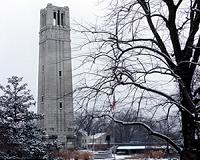 |
Boulder CO (SPX) Aug 16, 2010 For all who have ever lain on their backs and gazed at clouds adrift in the blue: A new NOAA study has found that clouds "communicate" with each other, much like chirping crickets or flashing fireflies on a summer night. The study, published online in the journal Nature, also has significant implications for our understanding of climate change. "Clouds organize in distinct patterns that are fingerprints of myriad physical processes," Feingold explained. "Precipitation can generate fascinating honeycomb-like patterns that are clearly visible from satellites. Cloud fields organize in such a way that their components 'communicate' with one another and produce regular, periodic rainfall events." While the discovery of synchronized behavior in clouds is one of many recent findings on self-organization in nature, the study also examines how suspended particles, or aerosols, in the atmosphere can influence these patterns and be a factor in climate change. The team, which also includes Ilan Koren of the Weizmann Institute, Hailong Wang of Pacific Northwest National Laboratory, Huiwen Xue of Peking University, and Alan Brewer of NOAA, used satellite imagery to identify cloud systems with a "cellular, almost honeycomb-like structure." In such systems, thick clouds form the walls of the honeycomb, and cloud-free zones form the open cells between the walls. The team also observed that these cellular structures constantly rearrange themselves, with cloud walls dissolving and open cells forming in their place, while walls form where open cells once existed. Using computer models, the scientists reproduced this rearrangement or oscillation of the cloud honeycomb pattern, and identified the driving factor - rain. Next, they analyzed scanning laser measurements from a ship cruising under cloud systems to verify their model results. "Together, these analyses demonstrated that the rearrangement is a result of precipitation, and that clouds belonging to this kind of system rain almost in unison," Feingold said. How does this synchronization come about? Falling rain cools the air as it descends. This creates downward air currents. These downdrafts hit the surface, flow outward and collide with each other, forming updrafts. The air flowing up creates new clouds in previously open sky as older clouds dissipate. Then the new clouds rain, and the oscillating pattern repeats itself. "Once precipitation ensues and an open structure has formed, it is difficult to revert the cloud field to a closed-cell, or overcast state," Feingold said. "Rain keeps the oscillating, open honeycomb pattern in motion, which allows more sun to reach Earth's surface." The scientists say that their findings point to a significant influence of particulate matter, or aerosols, on the large-scale structure of clouds and therefore on climate change. Scientists have long known that aerosols can influence local rain formation and block solar energy from reaching the Earth's surface-for an overall surface cooling effect. However, until recently, the scientific community has not considered the self-organization that results from these effects. Computer simulations for this study indicate that high aerosol concentrations favor the formation of large, dense cloud fields with less open space and less rain. This creates a more reflective cloud pattern and cooling of the surface. Low particulate levels in computer models resulted in rain and the open honeycomb structure with an oscillating pattern. The open honeycomb structure in a large cloud field lets more sunlight reach the surface, and hence results in surface warming. "Our work also suggests that we should expand our thinking about interactions between aerosols and clouds," Feingold said. "Integrating our current focus on fundamental physical processes with broader studies on system dynamics could give us a more complete understanding of climate change."
Share This Article With Planet Earth
Related Links NOAA Earth System Research Laboratory Weather News at TerraDaily.com
 New Methodology Improves Winter Climate Forecasting
New Methodology Improves Winter Climate ForecastingRaleigh NC (SPX) Jul 22, 2010 It's hot out right now, but new research from North Carolina State University will help us know what to expect when the weather turns cold. Researchers have developed a new methodology that improves the accuracy of winter precipitation and temperature forecasts. The tool should be valuable for government and utility officials, since it provides key information for use in predicting energy ... read more |
|
| The content herein, unless otherwise known to be public domain, are Copyright 1995-2010 - SpaceDaily. AFP and UPI Wire Stories are copyright Agence France-Presse and United Press International. ESA Portal Reports are copyright European Space Agency. All NASA sourced material is public domain. Additional copyrights may apply in whole or part to other bona fide parties. Advertising does not imply endorsement,agreement or approval of any opinions, statements or information provided by SpaceDaily on any Web page published or hosted by SpaceDaily. Privacy Statement |